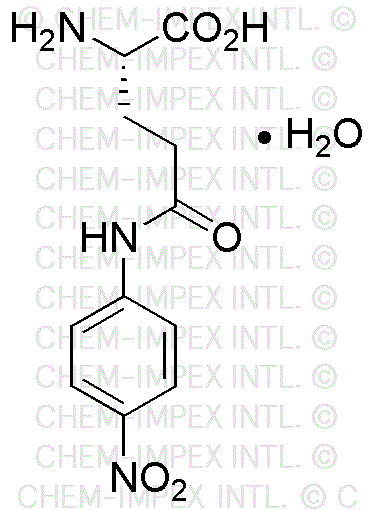L-Glutamic acid 5-(4-nitroanilide) monohydrate is widely utilized in research focused on:
- Biochemical assays: This compound serves as a substrate in enzyme assays, particularly for glutamate dehydrogenase, allowing researchers to study enzyme kinetics and metabolic pathways.
- Pharmaceutical development: It is used in drug formulation and testing, particularly in the development of neuroprotective agents, due to its role in neurotransmitter signaling.
- Food industry: As a flavor enhancer, it can improve the taste profile of various food products, making it valuable for food scientists and manufacturers.
- Diagnostics: The compound is employed in diagnostic tests for certain diseases, helping healthcare professionals identify conditions related to amino acid metabolism.
- Research on neurological disorders: It is utilized in studies investigating the role of glutamate in neurodegenerative diseases, providing insights that could lead to new therapeutic strategies.
General Information
Properties
Safety and Regulations
Applications
L-Glutamic acid 5-(4-nitroanilide) monohydrate is widely utilized in research focused on:
- Biochemical assays: This compound serves as a substrate in enzyme assays, particularly for glutamate dehydrogenase, allowing researchers to study enzyme kinetics and metabolic pathways.
- Pharmaceutical development: It is used in drug formulation and testing, particularly in the development of neuroprotective agents, due to its role in neurotransmitter signaling.
- Food industry: As a flavor enhancer, it can improve the taste profile of various food products, making it valuable for food scientists and manufacturers.
- Diagnostics: The compound is employed in diagnostic tests for certain diseases, helping healthcare professionals identify conditions related to amino acid metabolism.
- Research on neurological disorders: It is utilized in studies investigating the role of glutamate in neurodegenerative diseases, providing insights that could lead to new therapeutic strategies.
Documents
Safety Data Sheets (SDS)
The SDS provides comprehensive safety information on handling, storage, and disposal of the product.
Product Specification (PS)
The PS provides a comprehensive breakdown of the product’s properties, including chemical composition, physical state, purity, and storage requirements. It also details acceptable quality ranges and the product's intended applications.
Certificates of Analysis (COA)
Search for Certificates of Analysis (COA) by entering the products Lot Number. Lot and Batch Numbers can be found on a product’s label following the words ‘Lot’ or ‘Batch’.
*Catalog Number
*Lot Number
Certificates Of Origin (COO)
This COO confirms the country where the product was manufactured, and also details the materials and components used in it and whether it is derived from natural, synthetic, or other specific sources. This certificate may be required for customs, trade, and regulatory compliance.
*Catalog Number
*Lot Number
Safety Data Sheets (SDS)
The SDS provides comprehensive safety information on handling, storage, and disposal of the product.
DownloadProduct Specification (PS)
The PS provides a comprehensive breakdown of the product’s properties, including chemical composition, physical state, purity, and storage requirements. It also details acceptable quality ranges and the product's intended applications.
DownloadCertificates of Analysis (COA)
Search for Certificates of Analysis (COA) by entering the products Lot Number. Lot and Batch Numbers can be found on a product’s label following the words ‘Lot’ or ‘Batch’.
*Catalog Number
*Lot Number
Certificates Of Origin (COO)
This COO confirms the country where the product was manufactured, and also details the materials and components used in it and whether it is derived from natural, synthetic, or other specific sources. This certificate may be required for customs, trade, and regulatory compliance.


